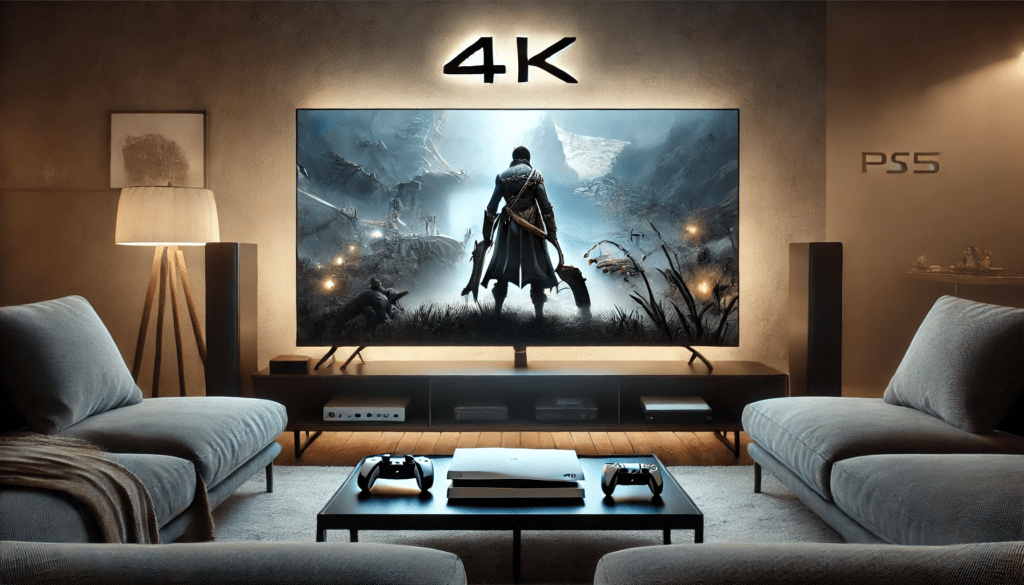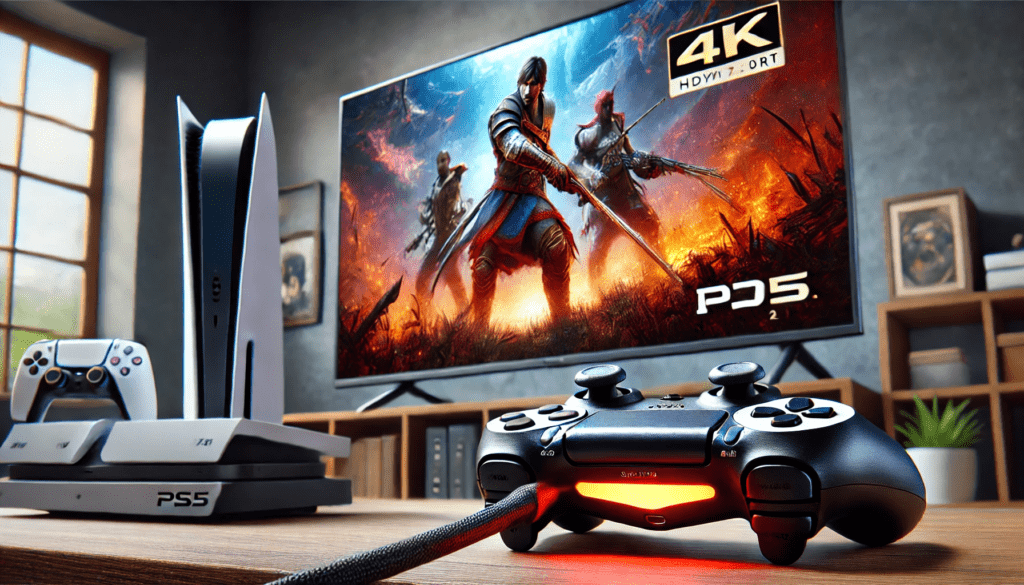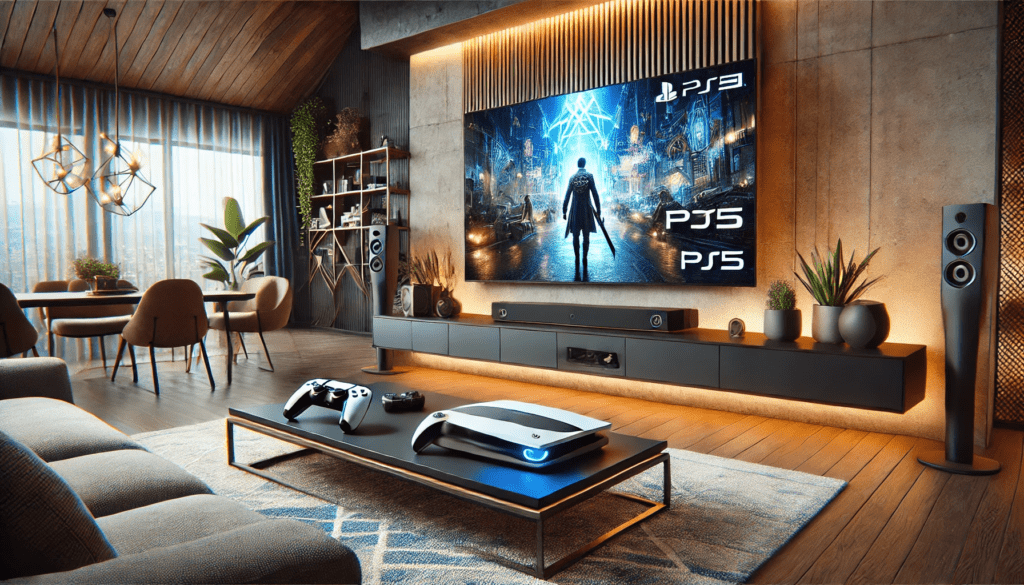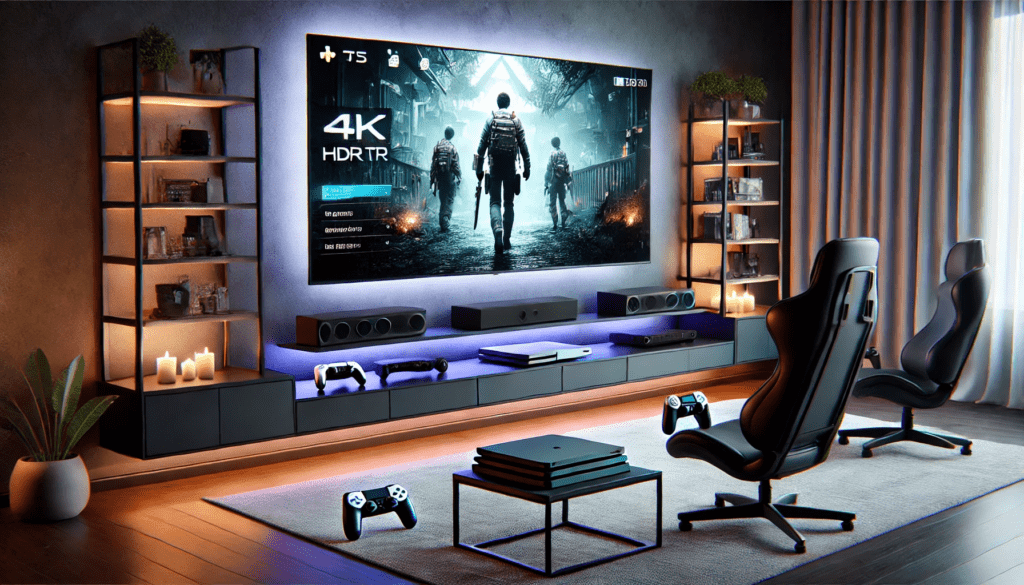PS5 TV Requirements: Your Best Guide in 2025
The PlayStation 5 (PS5) is a powerful gaming console that delivers stunning graphics and immersive gameplay. To fully experience what the PS5 has to offer, it’s crucial to understand the PS5 TV requirements. Choosing the right TV can significantly enhance your gaming experience, providing you with better visuals, faster response times, and smoother gameplay. In this guide, we’ll explore everything you need to know about PS5 TV requirements, ensuring you make the best choice for your gaming setup.

Display Resolution and Frame Rate
Understanding 4K Resolution
One of the essential PS5 TV requirements is the resolution. The PS5 TV requirements include supporting up to 4K resolution, providing a crystal-clear and detailed visual experience. A 4K TV has four times the number of pixels as a Full HD TV, which means more detail and clarity in the images displayed. When selecting a TV, ensure it supports 4K resolution to take full advantage of the PS5 TV requirements. This enhanced resolution is crucial for games designed to offer stunning, realistic visuals that can immerse you in their worlds.
Importance of High Frame Rates
Another crucial aspect of PS5 TV requirements is the frame rate. The PS5 TV requirements specify that the PS5 can deliver up to 120 frames per second (fps), offering smooth and fluid motion, especially in fast-paced games. Look for a TV that supports a refresh rate of at least 120Hz to match the PS5’s frame rate. This ensures that you won’t experience motion blur or lag during gameplay, which is particularly important for competitive gaming where every millisecond counts. High frame rates make movements appear more natural and can provide a significant edge in reaction times during intense gaming sessions, aligning perfectly with the PS5 TV requirements.
HDMI 2.1: A Must-Have
What is HDMI 2.1?
HDMI 2.1 is a vital component of PS5 TV requirements. It is the latest HDMI standard that supports higher resolutions and frame rates. HDMI 2.1 can handle 4K at 120Hz, ensuring you get the best possible performance from your PS5. When shopping for a TV, make sure it has HDMI 2.1 ports to fully utilize the PS5 TV requirements. This connection type also supports new gaming features that enhance overall playability, making it an essential part of the PS5 TV requirements for an optimal gaming experience.
Benefits of HDMI 2.1
The benefits of HDMI 2.1 go beyond just higher resolution and frame rates. It also supports features like Variable Refresh Rate (VRR) and Auto Low Latency Mode (ALLM). As part of the PS5 TV requirements, VRR eliminates screen tearing by synchronizing the TV’s refresh rate with the game’s frame rate, providing a smoother gaming experience. ALLM automatically switches the TV to game mode when you start playing, reducing input lag and ensuring responsive gameplay. Additionally, HDMI 2.1 supports an enhanced audio return channel (eARC), which improves audio quality for an even more immersive gaming experience, further aligning with the PS5 TV requirements. These features make HDMI 2.1 a crucial component of the PS5 TV requirements for optimal gaming performance.
HDR Support
What is HDR?
High Dynamic Range (HDR) is another important aspect of PS5 TV requirements. HDR enhances the contrast and color range of images, making them look more vibrant and realistic. The PS5 supports HDR10, so it’s essential to choose a TV that also supports HDR to fully enjoy the enhanced visuals. As part of the PS5 TV requirements, HDR makes bright areas of the screen appear brighter and dark areas darker, adding depth and detail to the images. Ensuring your TV meets these PS5 TV requirements will significantly enhance your gaming experience by providing more vivid and lifelike visuals.
Types of HDR
There are different types of HDR, including HDR10, Dolby Vision, and HLG. While HDR10 is the most common and widely supported, Dolby Vision offers a more advanced HDR experience with dynamic metadata that adjusts the picture quality scene by scene. To meet the PS5 TV requirements and achieve the best possible HDR performance, look for a TV that supports both HDR10 and Dolby Vision. This will ensure compatibility with a wide range of content and future-proof your setup against new HDR standards. By adhering to these PS5 TV requirements, you can enjoy a superior visual experience with enhanced depth, color, and detail in your gaming sessions.
Input Lag and Response Time
Why Input Lag Matters
Input lag is the delay between pressing a button on your controller and seeing the action on the screen. For a seamless gaming experience, it’s crucial to minimize input lag. Low input lag is a key component of PS5 TV requirements. Look for a TV with an input lag of 20ms or less to ensure responsive gameplay. Meeting these PS5 TV requirements is essential because high input lag can make games feel sluggish and unresponsive, which can be frustrating and impact your performance, especially in fast-paced games. Ensuring your TV meets these PS5 TV requirements will provide a more enjoyable and competitive gaming experience.
Understanding Response Time
Response time is the speed at which a TV’s pixels can change color. A lower response time reduces motion blur and ghosting, which are particularly noticeable in fast-paced games. As part of the PS5 TV requirements, aim for a TV with a response time of 5ms or lower to ensure crisp and clear images during gameplay. Meeting these PS5 TV requirements ensures that fast-moving objects are rendered smoothly, providing a more lifelike gaming experience. Ensuring your TV adheres to these PS5 TV requirements will significantly enhance the visual quality and responsiveness of your gaming sessions.
Screen Size and Viewing Distance
Choosing the Right Screen Size
The size of your TV screen is a personal preference, but it’s also an important factor in PS5 TV requirements. A larger screen provides a more immersive experience, but it’s essential to consider your viewing distance. Sitting too close to a large screen can cause eye strain while sitting too far can make it difficult to see fine details.
As part of the PS5 TV requirements, a good rule of thumb is to sit at a distance that is approximately 1.5 to 2.5 times the diagonal screen size. This ensures that you get a balanced and comfortable viewing experience without compromising on visual quality. Following these PS5 TV requirements will help you choose the right screen size for an optimal gaming experience.
Optimal Viewing Distance
For a 55-inch TV, the optimal viewing distance is between 6.5 and 10 feet. For a 65-inch TV, it’s between 8 and 13 feet. Adjust your viewing distance based on your TV size to ensure the best possible gaming experience. This range allows you to see all the details and enjoy the immersive visuals without straining your eyes. If you have a smaller room, consider a slightly smaller TV to maintain an appropriate viewing distance. Following these PS5 TV requirements will help you achieve the ideal setup for a comfortable and visually impressive gaming experience.
Smart TV Features

Importance of Smart TV Capabilities
While not directly related to PS5 TV requirements, having smart TV features can enhance your overall experience. Smart TVs offer a range of apps and streaming services, allowing you to switch between gaming and other entertainment options seamlessly. Look for a TV with a user-friendly interface and support for popular streaming apps like Netflix, Hulu, and Disney+. This versatility makes it easy to enjoy a variety of content on your TV.
Voice Control and Integration
Voice control and smart home integration are also valuable features to consider. Many modern TVs support voice assistants like Alexa or Google Assistant, making it easy to control your TV with voice commands. Additionally, integrating your TV with your smart home setup can provide a more convenient and connected experience.
For example, you can use voice commands to turn on the TV, adjust the volume, or switch between inputs without needing a remote control. These features enhance the usability of your TV and align with PS5 TV requirements by providing seamless and intuitive control options, contributing to an overall better gaming and entertainment experience.
Audio Quality
Built-in Speakers vs. External Sound Systems
While the PS5 delivers stunning visuals, don’t overlook the importance of audio quality in PS5 TV requirements. Built-in TV speakers often lack the depth and clarity needed for an immersive gaming experience. Consider investing in a soundbar or a surround sound system to enhance the audio quality. External audio systems can provide richer, more detailed sound that complements the high-quality visuals of the PS5.
Audio Features to Look For
When selecting a TV, look for audio features such as Dolby Atmos support, which provides a more immersive and three-dimensional sound experience. Additionally, ensure your TV has HDMI ARC (Audio Return Channel) or eARC to easily connect to external audio devices. These features ensure that you get the best possible audio performance from your gaming setup, enhancing the overall experience.
Future-Proofing Your TV
Why Future-Proofing Matters
Technology is constantly evolving, and future-proofing your TV is an essential consideration in PS5 TV requirements. Choosing a TV with the latest features ensures that it remains compatible with new advancements and can provide a great gaming experience for years to come. Investing in a future-proof TV means you won’t have to upgrade as frequently, saving you money in the long run.
Features to Future-Proof Your TV
To future-proof your TV, look for features like HDMI 2.1, 4K resolution, high refresh rates, and HDR support. These features will ensure that your TV can handle future gaming consoles and advancements in gaming technology. Additionally, consider TVs that support 8K resolution, even if it’s not yet standard for gaming. While 8K content is limited, having an 8K TV ensures you’re ready for the next leap in visual quality.
Additional Considerations for the Best Gaming Experience
Game Mode and Picture Settings
Most modern TVs come with a “Game Mode” setting that optimizes the TV’s performance for gaming. This mode typically reduces input lag and enhances response time, ensuring a smoother and more responsive gaming experience. When setting up your TV for the PS5, make sure to enable Game Mode and adjust the picture settings for the best visual quality. Calibrating the brightness, contrast, and color settings can also enhance your gaming visuals.
Multi-View and Picture-in-Picture Features
Some TVs offer multi-view or picture-in-picture features, allowing you to watch multiple content sources simultaneously. This can be particularly useful if you want to game on your PS5 while keeping an eye on a live stream or sporting event. Check if your TV supports these features and how they can be integrated into your gaming setup.
Refresh Rate and Adaptive Sync Technologies
In addition to HDMI 2.1, consider TVs that support adaptive sync technologies like AMD FreeSync or NVIDIA G-Sync. These technologies further reduce screen tearing and ensure smoother gameplay by synchronizing the TV’s refresh rate with the game’s frame rate. While not all TVs support these technologies, they can significantly enhance the gaming experience for PS5 users.
Choosing the Right TV Brand
Popular TV Brands for Gaming
Several TV brands are known for their excellent gaming performance and adherence to PS5 TV requirements. Brands like LG, Samsung, Sony, and Vizio offer a range of models that cater to different budgets and preferences. Each brand has its strengths, so it’s important to research and compare models to find the best fit for your needs.
Comparing TV Models
When comparing TV models, look at factors such as display technology (OLED, QLED, LED), screen size, input lag, response time, and smart features. OLED TVs, for example, offer superior contrast and color accuracy, making them an excellent choice for gaming. QLED TVs, on the other hand, provide brighter images and are often more affordable. Understanding the differences between these technologies can help you make an informed decision.
The Impact of TV Settings on Gaming Performance
Calibration and Custom Settings
Properly calibrating your TV can make a significant difference in gaming performance. Many TVs come with pre-set picture modes, but customizing the settings to suit your preferences can enhance the experience. For example, adjusting the sharpness, color temperature, and motion smoothing settings can improve the visual quality of your games.
Dynamic Range and Color Accuracy
Ensuring that your TV has a wide dynamic range and accurate color representation is crucial for an immersive gaming experience. HDR support enhances the dynamic range, but proper calibration ensures that the colors are accurate and vibrant. Use calibration tools or professional calibration services to fine-tune your TV’s settings for the best possible performance.
The Role of TV Positioning and Setup
Optimal TV Placement
The placement of your TV can impact your gaming experience. Ensure that your TV is positioned at eye level and at an appropriate distance from your seating area. This minimizes neck strain and provides a more comfortable viewing experience. Additionally, consider the lighting in your room, as glare from windows or lights can affect the visibility of the screen.
Wall Mounting vs. Stand Placement
Decide whether you want to mount your TV on the wall or place it on a stand. Wall mounting can save space and provide a cleaner look, but it requires proper installation to ensure the TV is secure. Stand placement, on the other hand, allows for more flexibility in positioning and easier access to ports and connections.
The Benefits of Gaming Monitors vs. TVs

Advantages of Gaming Monitors
While TVs are the traditional choice for console gaming, gaming monitors have become increasingly popular. Monitors typically offer lower input lag and faster response times compared to TVs. They are also designed to support high refresh rates and adaptive sync technologies, making them a viable option for PS5 gaming.
Choosing Between a Monitor and a TV
When deciding between a gaming monitor and a TV, consider factors such as screen size, resolution, and your gaming environment. Monitors are ideal for smaller setups and competitive gaming, while TVs provide a more immersive experience for casual gaming and multimedia use. Ultimately, the choice depends on your preferences and gaming habits.
Emerging Technologies in TV and Gaming
The Rise of 8K Resolution
While 4K is currently the standard for gaming, 8K resolution is emerging as the next frontier. 8K TVs offer four times the resolution of 4K, providing incredibly detailed and lifelike images. Although 8K content is still limited, investing in an 8K TV can future-proof your setup for the next generation of gaming and entertainment.
The Potential of MicroLED Displays
MicroLED technology is another emerging trend in the TV industry. MicroLED displays offer superior brightness, color accuracy, and contrast compared to traditional LED and OLED displays. They also have a longer lifespan and are less prone to burn-in. As this technology becomes more accessible, it could revolutionize the gaming experience.
FAQs
What is the ideal screen size for gaming on the PS5?
The ideal screen size depends on your viewing distance and personal preference. Generally, a 55-inch or 65-inch TV provides a great balance between size and immersion. Ensure you sit at an appropriate distance to avoid eye strain and fully enjoy the gaming experience.
Why is HDMI 2.1 important for the PS5?
HDMI 2.1 is crucial for the PS5 because it supports higher resolutions and frame rates, such as 4K at 120Hz. It also enables features like Variable Refresh Rate (VRR) and Auto Low Latency Mode (ALLM), which enhance the gaming experience by reducing screen tearing and input lag.
Can I use a 1080p TV with the PS5?
Yes, you can use a 1080p TV with the PS5, but you won’t be able to take full advantage of the console’s capabilities. The PS5 is designed to deliver 4K resolution and higher frame rates, so using a 4K TV with HDMI 2.1 ports is recommended for the best experience.
What is input lag, and why does it matter?
Input lag is the delay between pressing a button on your controller and seeing the action on the screen. Low input lag is essential for a responsive gaming experience. Aim for a TV with an input lag of 20ms or less to minimize delays and improve gameplay responsiveness.
Do I need a TV with HDR support for the PS5?
While not mandatory, having a TV with HDR support enhances the visual experience by providing better contrast and color range. The PS5 supports HDR10, so choosing a TV with HDR capabilities will allow you to enjoy more vibrant and realistic visuals.
What is Variable Refresh Rate (VRR)?
Variable Refresh Rate (VRR) is a feature that synchronizes the TV’s refresh rate with the game’s frame rate, reducing screen tearing and providing smoother gameplay. TVs with HDMI 2.1 ports typically support VRR, making it an important feature for PS5 TV requirements.
What are the benefits of Dolby Vision compared to HDR10?
Dolby Vision offers a more advanced HDR experience than HDR10 by using dynamic metadata. This allows for scene-by-scene adjustments to brightness and color, resulting in more accurate and realistic images. If you want the best HDR performance, choose a TV that supports both HDR10 and Dolby Vision.
How can I reduce input lag on my TV?
To reduce input lag, enable the Game Mode setting on your TV. This mode optimizes the TV’s performance for gaming by reducing processing time. Additionally, ensure your TV firmware is up to date, and use high-quality HDMI cables to minimize signal degradation.
Are OLED TVs better for gaming than LED TVs?
OLED TVs offer superior contrast and color accuracy compared to LED TVs, making them an excellent choice for gaming. However, OLEDs are more expensive and can be prone to burn-in if static images are displayed for long periods. LED TVs are generally more affordable and offer higher brightness levels, making them suitable for well-lit rooms.
Can I use a soundbar with my PS5?
Yes, using a soundbar can significantly enhance the audio quality of your gaming experience. Look for soundbars that support Dolby Atmos or DTS
for immersive surround sound. Ensure your TV has HDMI ARC or eARC ports to connect the soundbar easily.
What is the difference between HDMI ARC and eARC?
HDMI ARC (Audio Return Channel) and eARC (Enhanced Audio Return Channel) allow audio to be sent from your TV to an external audio device, such as a soundbar. eARC supports higher bandwidth audio formats, including uncompressed Dolby Atmos and DTS, providing better audio quality compared to ARC.
Is it worth investing in an 8K TV for the PS5?
While 8K content is still limited, investing in an 8K TV can future-proof your setup for the next generation of gaming and entertainment. The PS5 currently supports up to 4K resolution, but as 8K content becomes more widely available, having an 8K TV will ensure you’re ready for the next leap in visual quality.
How do adaptive sync technologies like FreeSync and G-Sync enhance gaming?
Adaptive sync technologies like FreeSync and G-Sync synchronize the TV’s refresh rate with the game’s frame rate, reducing screen tearing and providing smoother gameplay. These technologies are particularly beneficial for fast-paced games, where even minor disruptions in frame rate can impact the gaming experience.
What is the difference between QLED and OLED TVs?
QLED TVs use Quantum Dot technology to enhance brightness and color accuracy, making them suitable for well-lit rooms. OLED TVs, on the other hand, offer superior contrast and true black levels by individually lighting each pixel. Both technologies have their strengths, so choosing between them depends on your preferences and gaming environment.
How can I optimize my TV’s settings for the best gaming experience?
To optimize your TV’s settings for gaming, enable Game Mode, adjust the picture settings for optimal brightness and contrast, and calibrate the color settings for accurate representation. Using calibration tools or professional calibration services can further enhance the visual quality of your games.
What are the advantages of using a gaming monitor instead of a TV?
Gaming monitors typically offer lower input lag, faster response times, and higher refresh rates compared to TVs. They are designed specifically for gaming and can provide a more responsive and smooth experience. Monitors are ideal for competitive gaming and smaller setups, while TVs offer larger screen sizes for a more immersive experience.

Conclusion
Choosing the right TV for your PS5 is essential for a superior gaming experience. Understanding the key PS5 TV requirements such as resolution, frame rate, HDMI 2.1, HDR support, input lag, and response time will help you make an informed decision. Remember to consider future-proofing features to ensure your TV remains compatible with new advancements in gaming technology.
For more tips on enhancing your gaming setup, check out our article on the best 38-inch gaming monitor. Additionally, you can visit external resources like HDMI.org and Rtings.com for in-depth TV reviews and comparisons. Investing in the right TV will not only enhance your PS5 gaming experience but also provide great performance for all your entertainment needs.

Your point of view caught my eye and was very interesting. Thanks. I have a question for you.